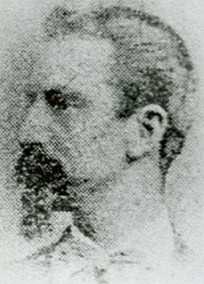Charles A. Coolidge
| Charles Austin Coolidge, Jr. | |
|---|---|
 Lt. Charles A. Coolidge circa 1875 | |
| Born |
July 19, 1844 Boston, Massachusetts |
| Died |
June 1, 1926 (aged 81) Detroit, Michigan |
| Place of Burial | Arlington National Cemetery |
| Allegiance |
United States of America Union |
| Service/branch |
United States Army Union Army |
| Years of service | 1862–1903 |
| Rank | Brigadier General |
| Commands held | 9th U.S. Infantry |
| Battles/wars |
American Civil War Spanish-American War Philippine-American War China Relief Expedition |
Charles Austin Coolidge, Jr. (July 19, 1844 - June 1, 1926) was a United States Army soldier who served in the American Civil War, the American West, Spanish-American War, and in Asia before retiring in 1903 as a brigadier general.
Early life, education & marriage
Charles Austin Coolidge, Jr. was born on July 19, 1844 in Boston, Massachusetts to Charles Austin Coolidge, Sr. and Anna Maria (Rice) Coolidge. He attended Norwich University in Northfield, Vermont where he received the degree of B.S. Later he received a medical (MD) degree from the Wooster Medical College in Wooster, Ohio. He married Sophie Wager Lowry, daughter of Philip Lowry and Caroline Tilghman of Philadelphia, on 19 November 1867 at Tallahassee, Florida.
Military career
On 23 Oct 1862, Coolidge enlisted in the United States Army as a private in the 16th Massachusetts Volunteer Infantry Regiment. In May 1864 he was appointed Second Lieutenant of the Seventh Infantry Regiment. The Seventh at that time was on duty in New York, having just come from Gettysburg for the draft riots. Following a month of service at City Point, Virginia, the regiment remained at New York harbor until the end of the war. The regiment was then sent to Florida for the next five years.
After his unit was transferred to the American West in 1870, Lieutenant Coolidge was a member of Captain Brown’s command which opposed Chief Joseph’s Nez Percé Indians at Lolo Pass. He was wounded in this campaign at the Battle of the Big Hole on August 9, 1877. Later when appointed a Captain, he served in Montana, Dakota Territory, Fort Snelling, Fort D.A. Russell (Wyoming), Rock Springs, Wyoming, and Fort Logan near Denver, Colorado.
At the outbreak of the Spanish-American War in April 1898, Coolidge attained the rank of Major in the Seventh Infantry Regiment. He participated in the capture of El Caney on July 1, 1898 and the bombardment of Santiago de Cuba.

In 1901 Coolidge was named Colonel of the Seventh Infantry Regiment, transferred to the Presidio of San Francisco, where he retired August 8, 1903 as a Brigadier General.[3]
Retirement and death
Coolidge moved to Detroit shortly after the San Francisco earthquake in August 1906. He had been exceptionally active in work of military veterans' organizations and he was a member of the Loyal Legion, the GAR, Sons of the American Revolution and the Spanish War Society. He was a Councilor of the Boy Scouts of America and a President of the American Philatelic Society. He was admitted to the Detroit Post of the GAR in 1906, elected Junior Commander two years later and named Commander in 1912. Brigadier General Charles Austin Coolidge died June 2, 1926 at Grace Hospital in Detroit, Michigan in his eighty-first year. He had been ill since May 19, 1926 when he suffered a stroke while attending the Lloyd Tilghman monument unveiling at Vicksburg, Mississippi. He was buried at Arlington National Cemetery.
Military awards
General Coolidge earned the following military awards:
- Civil War Campaign Medal

- Indian Campaign Medal

- Spanish Campaign Medal

- Philippine Campaign Medal

- China Relief Expedition Medal

Family relations & genealogy
Charles A. Coolidge and his wife Sophie in 1870 adopted a son, Sherman Coolidge (1862–1932) of Arapahoe ancestry, who became a prominent leader in the Native American community.[4] General Coolidge was the son of Charles and Anna Maria Rice Coolidge. He was a direct descendant of John Coolidge (1604-1691) who emigrated from England about 1630 to Watertown, Massachusetts, and he was a cousin of President Coolidge. His grandfather Henry Rice was a member of the Boston City Council and was a Massachusetts state legislator. He was also a descendant of Edmund Rice another early immigrant to Massachusetts Bay Colony as follows:[5][6]
- Brig. Gen Charles A. Coolidge (1844–1926), son of
- Anna Maria Rice (1817-1886), daughter of
- Henry Rice (1786-1867), son of
- Noah Rice (1751-1820), son of
- Jabez Rice (1702-1783), son of
- Caleb Rice (1666-1739), son of
- Joseph Rice (1637-1711), son of
- Edmund Rice, (ca1594-1663)
See also
References
- ↑ "Colonel Emerson C. Liscom". Arlington National Cemetery. Retrieved 27 Nov 2009.
- ↑ "Colonel Meade Invalided Home". New York Times July 27, 1900. July 27, 1900. Retrieved 7 Nov 2009.
- ↑ "Obituary of Brig. Gen. Charles A. Coolidge". Arlington National Cemetery. Retrieved 7 Nov 2009.
- ↑ "Sherman Coolidge Biography". Friends of Nez Perce Battlefields. Retrieved 7 Nov 2009.
- ↑ "Edmund Rice Genealogy: First Six Generations". The Edmund Rice (1638) Association, Inc. Retrieved 7 Nov 2009.
- ↑ Edmund Rice (1638) Association, 2009. Descendants of Edmund Rice: The First Nine Generations. (CD-ROM)